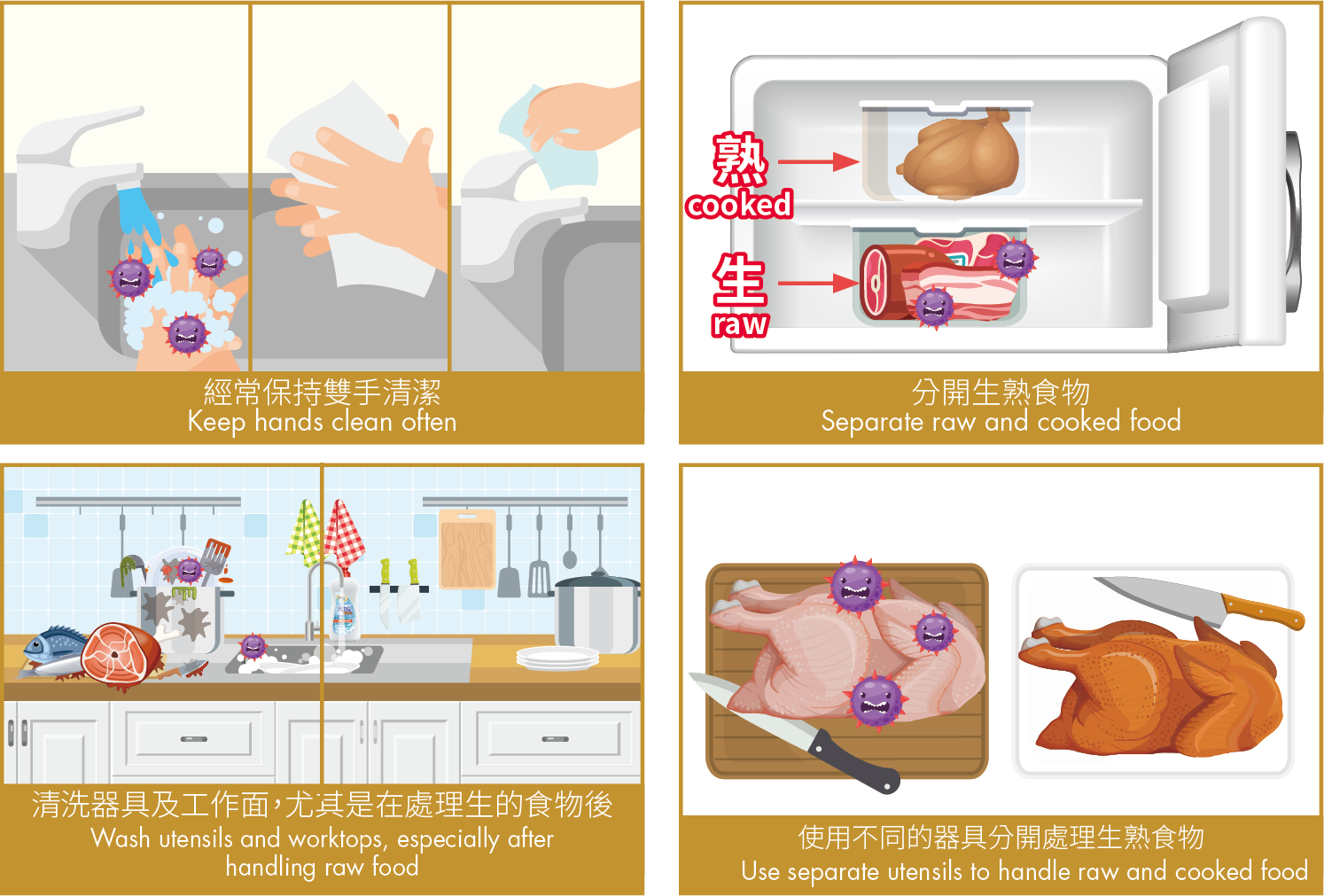
Food Safety Focus (161st Issue, December 2019) – Incident in Focus
Cross-contamination of Ready-to-eat Food
Reported by Dr. Ken CHONG, Scientific Officer,
Risk Communication Section, Centre for Food Safety
Background
In October 2019, there were two separate food poisoning outbreaks suspected to be caused by Vibrio parahaemolyticus. Stool specimens of two affected persons in one of the outbreaks were later tested positive for the bacterium. The suspected incriminated food items in the outbreaks were lo-mei, cooked chicken and chicken rice. Since Vibrio parahaemolyticus usually occurs in seafood, cross-contamination likely contributed to the outbreaks.

Highlight of ways to prevent cross-contamination.
Cross-contamination is not Uncommon
Cross contamination is a common contributing factors for food poisoning outbreaks and is amongst the top two most common identified contributing factors for food poisoning outbreaks related to local food premises and food business in 2017 and 2018 respectively. Regarding the two outbreaks in October mentioned earlier, improper food-handling practices risking cross-contamination were identified upon investigation at the food premises. For example, placing uncooked seafood at food-handling area for handling ready-to-eat food, storing uncovered raw shellfish together with ready-to-eat chicken in the same compartment of the fridge, and unsatisfactory hand hygiene practice of food handlers are all possible routes of cross-contamination.
Different Ways of Spreading
Cross-contamination refers to the transfer of bacteria from one food, often raw, to another. Contamination in ready-to-eat food is of higher risk as there is no further cooking process to kill the bacteria before consumption.
In general, there are two ways how cross-contamination may occur. Firstly, bacteria can be transferred directly when one food touches or drips onto another. For example, if raw shellfish drips onto a cake in the fridge, bacteria will spread from the shellfish to the cake. Secondly, bacteria can be transferred indirectly from contaminated hands, equipment, kitchen utensils, work surfaces or even splashes to food. If food handlers do not wash their hands thoroughly after handling raw food, bacteria will be carried to whatever things, including ready-to-eat food, touched by contaminated hands. Similarly, cross-contamination can also happen when the same equipment or kitchen utensils are used for both raw and cooked/ready-to-eat foods without proper cleaning between uses. For example, if you cut a raw chicken on a chopping board, bacteria can spread from the raw chicken to the board or even into deep gouges or cuts on the board. If the same board is used without thorough cleaning, the bacteria will likely spread to the next cooked/ready-to-eat food applied to the board.
Washing raw meat and poultry can sometimes result in cross-contamination too, when bacteria in splashes can spread up to 80 cm from the sink causing contamination to nearby surfaces, utensils or food. If washing raw meat and poultry is necessary, thorough cleaning of the sink and its surrounding areas is very important to prevent cross-contamination.
Gold Rules: 5 Keys to Food Safety
The “5 Keys to Food Safety” are five simple and effective steps for people to prevent foodborne diseases when handling food. Here are some practical tips for all food handlers:
- During food preparation, food handlers should always wash their hands, especially after touching raw food and right before handling cooked/ready-to-eat food.
- Storage of raw food and cooked/ready-to-eat food in close proximity inside the same fridge should be avoided. Raw food should be placed below cooked/ready-to-eat food in the fridge to prevent juices from dripping onto cooked/ready-to-eat food.
- Wash utensils and worktops with hot water and detergent after each use, especially after preparing raw food.
- Use separate utensils to handle raw food and cooked/ready-to-eat food.
Key Points to Note
- Cross-contamination is a common contributing factor for food poisoning outbreaks.
- Cross-contamination from raw food can occur directly from contaminated food to other food, or indirectly by contaminated hands, equipment, work surfaces, utensils or splashes to other food.
- To prevent cross-contamination from happening, people should adhere strictly to the principles of the “5 Keys to Food Safety”, in particular always maintain good hand hygiene and separate raw food and cooked/ready-to-eat food well.
Advice to the Public
- Separate raw food, especially raw meat, poultry and seafood, from ready-to-eat food in your shopping trolley or basket.
- Place raw food in a separate bag or container to prevent its juice, if any, from dripping onto other foods.
Advice to the Trade
- Raw food should not be carried to the food-handling area for handling cooked/ready-to-eat food.
- Hand washing and drying facilities should be suitably located in food preparation or production areas to ensure they are readily accessible to food handlers. Where possible, non-hand operable taps and single-use towels should be equipped to help prevent re-contamination of clean hands.
- Ideally, install two refrigerators for storing raw food and cooked/ready-to-eat food separately.

